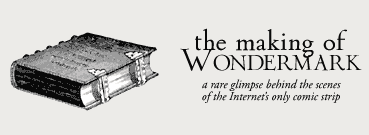
VI. LAYOUTS
The envelope is opened, its lightly-scented contents revealed, and the approved Script is on its way to becoming a fully-fledged, print-ready Strip.
At this point the paste-up composite of the approved script is carefully reviewed for composition, panel layout, balloon placement, and sprite ratio. Each of these factors has been carefully and precisely set by the creative personnel upstairs, and every detail must be retained as exactly as possible in the finished product.
Typically, the paste-up will be enlarged and projected onto a sheet of 32” x 40” illustration board (our liners use Crescent #200, extra heavy weight, hot press). The forms and gestures are lightly traced with a 5H or 6H pencil, and a digital photograph of the board is sent to the ballooner. The ballooner lays in rough dialogue balloons for reference, so that the penciller will know to leave space for the final balloons in the composition.
The paste-up is useful early on for giving the layout artists a vague indication of the preferred composition, but then it’s archived. The pencillers have found that they produce more evocative work when the Marvin or Jump Start or La Cucaracha panels that’ve been used in the paste-up are out of view.
VII. ROUGHS
The layouts complete, a high-resolution backup clone is made of the illustration board while the board itself is overnighted to the roughing studio in Korea. There, talented artists work from the existing layouts to rough in each panel’s shapes and forms, freeing the pencillers to concentrate on detail and expression rather than the technical minutiae of proportion and perspective. This process usually takes about two days per strip.

Roughs in Korean studio
VIII. PENCILS
Having seen the paste-up, the research team has already begun compiling reference material — photographs of needed props, Muybridge motion stills, or actual objects or models for the pencillers to draw from. A typical panel requires anywhere from six to ten reference items; some of the more exotic strips have required (as you will no doubt recognize) a bicycle-riding elephant, which was procured and brought into the studio; a seafaring schooner; two cows on a seesaw (actually one cow drawn twice); and a dead man.
When the roughs return from Korea, the pencillers begin the tedious job of creating images where before there were only vague images. They are a fastidious group, often working late into the night, and they have a powerful union, which means they take a lot of breaks. A typical comic panel may take two to four days to pencil, with up to six pencillers trading off in shifts.
The completed pencils are once again subject to the approval of the Creative Director before any ink is applied. This late approval is mostly a formality, as by now it’s relatively late in the game to switch gears, but some minor changes can be made if necessary.
IX. BALLOONS
Before the inking, the balloonist makes light sketches on the actual illustration board to indicate the size and placement of all word balloons. While many comic strips now use computers to add the word balloons and text over the finished art, Wondermark still employs the traditional balloonist and letterer, both artisans who were grandfathered in under the current union contract and neither of whom can be legally fired.
Their placement finalized, the balloonist begins crafting the balloons on a sheet of acetate that will overlay the inked board. This process is normally completed at the same time as the inking.
X. INKING
Perhaps the most exacting step in the creation of the finished strip is the inking process. Using Winsor & Newton Series 707 pure sable brushes (sizes 00 through 3), Rapidograph technical lining pens, and croquill nib pens with Pelikan india ink (below), the inkers interpret the precise pencils into bold black and white. This ensures the art’s archival quality and makes for easy and sharp reproduction.

Pelikan india ink
Fine artists in their own respect, a close-knit team of three inkers working in shifts can complete an entire strip in four days.
XI. LETTERING
Once the ink is dry, the letterer uses registration marks to lay the acetate sheet containing the opaque white balloons over the inked illustration board. A second acetate sheet containing the dialogue, written with fine-point dry-erase pens, is then laid over the balloon layer.
The entire creative crew, including the Creative Director and the Executive V. P., traditionally gather around an easel in the lunchroom to eat bagel chips and discuss the dialogue. At this stage alternate verbiage can easily be substituted in and evaluated with the finished artwork. The balloonist usually petitions against major changes, since it would mean re-painting the balloons. Minor changes he’s all for, however, and some of our best punch lines (“I hate cracker children!”) have been the balloonist’s.
When the best possible dialogue copy has been created by this committee, the letterer will use an Ames lettering guide and Rapidograph technical pens to transcribe it precisely onto a matte acetate sheet.
Now, so the world can see it: Click here for Part III (of III)
